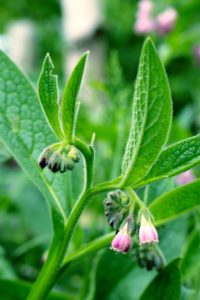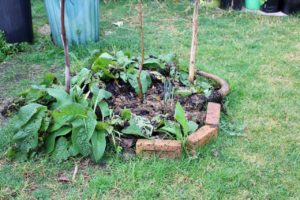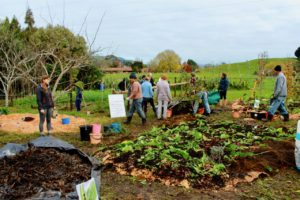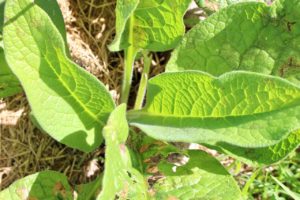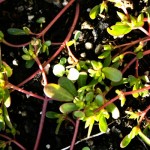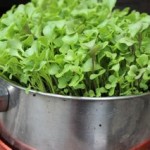Comfrey (Symphytum x uplandicum) is the comfrey we commonly have in New Zealand. It is a cross between wild comfrey S. officinale from Europe and S. asperum from Russia.
Also known as Knitbone, Boneset, Bruisewort, Slippery root and others it is a must have in the garden in my mind. It is a perennial plant that puts down very deep, thick roots used to bring up minerals from deep down and to break up compact soil. At this time in July the leaves are dying down for winter and they will rot and nourish the plants around where they grow. Comfrey is clump forming and doesn’t spread unless the roots are disturbed.
Comfrey has attractive drooping, pink to purply blue flowers that the
bumblebees go for. The large, rough and hairy egg to spear shaped leaves grow up to 30cm long by 12cm wide supported on hairy stems. The leaves
shade the ground and I’m using comfrey as a barrier to stop kikuyu invading an area around one of my fruit trees. This plant is so regenerative that one can cut the leaves down five times in a season and they will regrow. They can be used to make a liquid manure by soaking them in a bucket of water (you will need a lid because it will stink a sign that it has a high protein/nitrogen content) for a
couple of weeks and then watering that
diluted mineral rich liquid onto your vegetables. Use one leaf under each potato tuber and it will help feed the young growing potato. They can also be used as a layer in sheet mulching as you’ll see in the photo.
Comfrey is above all a miraculous healing plant, known to very quickly assist the body to heal any part that is torn or broken. It has a mucilaginous quality in the mashed leaves and roots that is soothing, stopping further
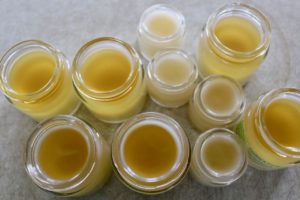
Joint balm with comfrey, kawakawa, St John’s wort, as well as lavender and winter green essential oils
damage and rebuilding cartilage, muscles and tendons. I make my joint balm using comfrey roots infused in olive oil for external use. I wouldn’t use comfrey roots internally because of the pyrrolizidine alkaloids that can cause liver damage. The leaves are edible however.
Allantoin is comfrey’s miraculous substance that stimulates the growth of new cells. It speedily heals sprained tendons, strained ligaments, fractures, broken bones, skin irritations and ulcers. A friend treated her husband by applying the leaves directly onto his ankle when he fell off a ladder. It healed so quickly he changed his mind about the power of comfrey. The same friend then used it on her own broken toe. She made poultices using cooked porridge as a paste to mix the mashed up comfrey leaves in (you can also use mashed leaves without the porridge paste). She put the mix between two pieces of gauze and froze them. She applied the poultice directly onto her broken toe. She said in both cases the results were amazing.
Comfrey leaves can be used chopped finely in salads, smoothies, soups, steamed like spinach, battered as fritters or as tea. They are high in protein,
potassium, calcium and Vitamins A, B12, C,. Comfrey is also a good spring tonic for cows, sheep goats and horses and helps cure laminitis – apply as a poultice.
My favourite herbalist Juliette de Baïracli Levy calls comfrey a ‘wonder’ herb and I can see why.
Coming up: Edible Weed workshop Sunday August 12th 2018 www.juliasedibleweeds.com/workshops
